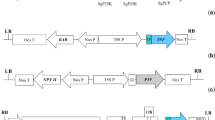Abstract
Using hygromycin B resistance as a marker for selection, we have established the conditions required for the transformation of Chlorella vulgaris. The exponentially grown C. vulgaris cells were transformed by electroporation with plasmid pIG121-Hm, and transformants were selected with hygromycin B at a concentration of 50 μg/ml. Cell extracts prepared from the late-log cultures of the transformants exhibited glucuronidase activities as conferred by the gus gene on pIG121-Hm. The maintenance of plasmid in the algal cells seemed to be transient as many cultures derived from the hygromycin B-resistant colonies gradually lost the hygromycin resistance upon prolonged growth. The result of Southern blotting of the genomic DNAs prepared from transformant cultures exhibiting persistent hygromycin resistance showed that integration of part of the plasmid DNA into the host chromosome had taken place.
Similar content being viewed by others
Author information
Authors and Affiliations
Additional information
Received: 19 December 1997 / Revision received: 5 October 1998 / Accepted: 27 October 1998
Rights and permissions
About this article
Cite this article
Chow, KC., Tung, W. Electrotransformation of Chlorella vulgaris. Plant Cell Reports 18, 778–780 (1999). https://doi.org/10.1007/s002990050660
Issue Date:
DOI: https://doi.org/10.1007/s002990050660




